HUMA Committee Report
If you have any questions or comments regarding the accessibility of this publication, please contact us at accessible@parl.gc.ca.
CHAPTER 1: ONLINE CONSULTATIONS: THE NEXT
STEP IN
PARLIAMENTARY DEMOCRACY
Like many studies by parliamentary committees, this study began because members of the Subcommittee recognized a problem. In this case, it concerned difficulties with the Canada Pension Plan Disability program (CPP(D)), the largest single disability income program in Canada; these difficulties were brought to our attention, as Members of Parliament, by our constituents. In very large numbers, people have been visiting MPs, talking with their assistants and corresponding about various issues with them regarding the operation of the CPP(D) and its shortcomings. With the support of colleagues from all parties in the House of Commons, the Subcommittee on the Status of Persons with Disabilities decided that something needed to be done. In addition, no parliamentary committee has immersed itself in the CPP(D) for many years. In an earlier report, A Common Vision, we expressed our concerns that:
… current disability income support programs operated by the federal government, notably the Canada Pension Plan Disability (CPP-D) have not recognized the fundamental realities of many people who live with a disability. It does not have human measures in place to provide prompt service; it does not adequately address the issues of cyclical and degenerative disease and it does not address the question of mental illness and disability in an appropriate fashion. As Members of Parliament, we constantly confront this reality in assisting our constituents who come to us for aid in finding a way through the bureaucratic jungle.1
We wanted Canadians to become more aware of, and involved in, our work as parliamentarians and as members of the Subcommittee but we also wanted to continue to have access to expertise that can enrich our activities. We decided to explore a way to combine the traditional work of a parliamentary committee — drafting a study plan, calling experts and departmental officials as witnesses to provide testimony, receiving briefs from interested parties, and preparing a report — with methods that would allow all Canadians with views on CPP(D) to participate. The Subcommittee, therefore, supported by the House of Commons and the Library of Parliament launched the first online consultation of any parliamentary committee in Canada and among the few carried out by any legislature in the world.
We believe that this report points the way in moving toward the next step in our evolving Canadian democracy. It puts together the wisdom of those who appeared in person before us during our hearings with the insights provided by 1,700 Canadians who participated in our study online. The conclusions and recommendations in this report, therefore, are based on what are probably the most widely-canvassed views ever solicited by a parliamentary committee. The Subcommittee hopes to follow-up on this first view of the future of the CPP(D) with a follow-up report that deals more extensively with the way that the disability income system works — or does not work — to support Canadians with disabilities.
In order for this complex process to succeed, we had to undertake some extensive preparations. After we agreed to begin our study of CPP(D) on 9 April 2002, the Subcommittee asked the Income Security Programs Branch of Human Resources Development Canada to brief us on the overall operation of the plan. The Office of the Commissioner of Review Tribunals told us about how it handles the appeals of Canadians whose applications for CPP(D) benefits have been turned down by the Department. Then on 21 May 2002, we held a roundtable where we brought together as many of the organizations, experts, and federal departments as we could gather together, to help us identify the issues that we should pay attention to during our study.
In June, the Subcommittee launched its information-based Web site so that all Canadians would be able to follow our work and contribute to our activities. The Subcommittee’s Web site includes, among other things, several policy papers on the CPP(D) program, some background documents on the history and past work of the Subcommittee, and a FAQ (frequently asked questions) section. The Subcommittee’s researchers from the Parliamentary Research Branch of the Library of Parliament were responsible for preparing these documents. The inclusion of these documents on the Subcommittee’s Web site represents a significant departure from the more traditional committee Web site which usually only includes a list of studies, members and reports, a notice of meetings, minutes of proceedings, evidence and index. For the first time, the authors were asked to submit their briefs electronically so that they could be made available to all those who visited the site. All this information was posted in a convenient and accessible location.
Those who were interested in our work could use the site to get information and resources about the Subcommittee’s study. For us, it was vital that people have information about what we are doing so that they could understand more about CPP(D), how it works and what suggestions had been made to improve it. We wanted Canadians to understand the challenges that exist with this program and to participate in our search for ways to better deal with them. The Subcommittee’s Web site was set up to help meet this goal, becoming the first step in gaining knowledge that allowed all interested citizens to help us with our work. This site also became a source of information about our activities allowing those who were appearing in person at our Subcommittee’s meetings to gain information that assisted them in preparing their testimony and briefs. This information site was in place for six months before we launched our e-consultation.
In these months, the site statistics revealed several interesting trends; visitors were coming to the site in impressive numbers and they were using the Web site as a research tool.
On the International Day of Persons with Disabilities, 3 December 2002, the Subcommittee on the Status of Persons with Disabilities launched the first online consultation by a Canadian parliamentary committee. The e-consultation provided Canadians with an opportunity to participate at their convenience during the 13-week online consultation process, running from 3 December 2002 to 3 March 2003. Three primary means permitted participation: completing an issue poll; sharing stories; and/or offering solutions to a range of issues facing the CPP(D) program. The issue poll, stories and proposed solutions covered a range of issues — from personal struggles to policy suggestions — from the application process to the Review Tribunal.
By completing the online issue poll, participants provided their viewpoints on major issues facing the Canada Pension Plan Disability program. People could either identify themselves and register, or could complete the issue poll anonymously. In a limited number of cases, some individuals filled out a paper version and submitted it to the Subcommittee by mail. Before taking the poll, individuals were informed that their answers would be used to assist the Subcommittee in formulating its report and recommendations. The issue poll allowed input from anyone who was interested in the CPP(D) program. While everyone was invited to participate, respondents were asked to identify themselves as members of particular groups (hereafter referred to as a “category of identification”), which included among others: people with disabilities, family members of people with disabilities, CPP contributors, CPP(D) recipients, medical professionals, advocates and employees of federal and provincial disability income support programs. Clearly, these categories of identification are not mutually exclusive and were only intended to give the Subcommittee a general idea of the type of respondents that would complete the issue poll, and to ensure that the issue poll was not “captured” by a particular interest group. The Web site displayed results of registered participants by province and territory. The Subcommittee had access to all results in real time as they were completed. Anonymous, or registered, all responses were analyzed by the research team.
The Subcommittee also asked Canadians to share the story of their experiences with the CPP(D) program (in no more than 500 words). Although the Subcommittee accepted stories on any subject related to the program, we were specifically interested in stories that addressed identified areas of concern. For example, the Subcommittee suggested that it would like to receive input on:
| • | possible changes to the eligibility requirements; |
| • | what worked well and what did not in the application, appeal and medical assessment process; |
| • | the financial challenges faced by CPP(D) applicants and appellants in terms of costs associated with fulfilling all requirements of the application and appeal process; |
| • | the adequacy of the benefit level; |
| • | the challenges associated with CPP(D) benefits being considered as taxable income; |
| • | how other programs, such as social assistance programs, private insurance and workers’ compensation programs, affected their experience with the CPP(D) program; and, |
| • | how work and a return-to-work strategy fit into a program like CPP(D). |
Those who shared their stories also had the choice of registering or remaining anonymous. In the latter case, the stories were not posted on the Subcommittee’s Web site, but were analyzed by our research team and used in preparing our report. Those who registered also had a choice: to share their stories on the Web site or with the Subcommittee only. Again, participants were informed that all stories would be used to help the Subcommittee to write its report and recommendations.
The Subcommittee further asked Canadians to present their proposed solutions to a range of challenges currently facing the Canada Pension Plan Disability program, such as:
| • | how to raise awareness of the CPP(D) program; |
| • | how to enhance or restructure the process behind CPP(D); |
| • | how to improve the application or appeal process; and |
| • | how to address the eligibility requirements. |
Participants had the same option for the solutions as they had for the stories; that is to register or remain anonymous.
Canadians responded to our effort at outreach in unprecedented numbers. Almost 1,500 Canadians participated in our issue poll, 135 people shared their stories and 28 individuals or advocacy groups provided solutions. The rich new input from this e-consultation has helped to shape the Subcommittee’s interim report and recommendations to House of Commons.
Anecdotal information, gathered through some of the stories and solutions presented to the Subcommittee, indicates that many Canadians who initially responded to the issue poll felt compelled to elaborate further on some of the issues that were raised. Accordingly, the profile of issue poll respondents gives, as well, a sense of who shared their stories and presented solutions to the Subcommittee.
With regard to the issue poll, the majority of respondents identified themselves as “persons with disabilities” (757 respondents2). The second most important group, 574 individuals, identified themselves as “contributors to the Canada Pension Plan on pay or income tax.” These groups are followed by respondents who identified themselves as “CPP(D) recipients” and as “family members of a person with a disability” (302 and 226, respectively). Other categories of respondents included CPP(D) applicants, CPP(D) appellants, legal representatives of persons with disabilities, employees of a federal/provincial disability income support program, employees in the insurance business, employees of a member of Parliament, employees of a disability association or advocacy group, rehabilitation specialist, medical doctors and other medical professionals. (Chart 1.1 shows the breakdown by category of respondents.3)
The issue poll results, furthermore, show that individuals from across the country participated in the Subcommittee’s e-consultation. The majority of respondents live in Ontario (519 respondents), followed by residents of British Columbia (187 respondents), the Atlantic Provinces4 and Alberta (115 respondents). The lower response rate in Québec can be explained by the fact that Québec has its own disability income replacement program separate from the CPP(D). We can safely conclude that we received information from all those that we set out to reach, and in this sense, our e-consultation succeeded.
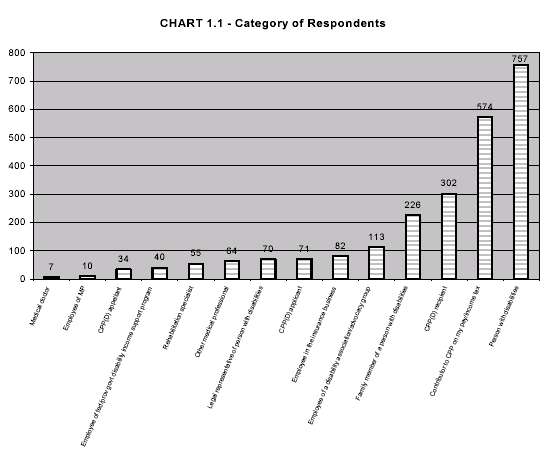
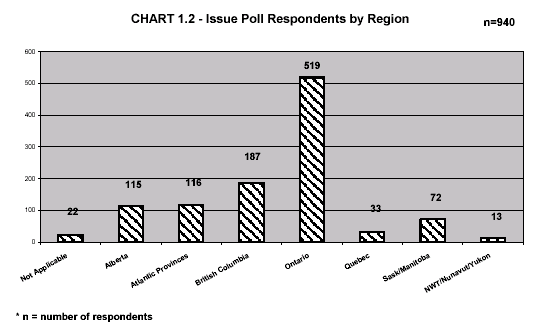
The vast majority of respondents (90%) fell between 30 to 65 years of age. This comes as no surprise, since an interest in income support programs such as the CPP(D) program is more likely to be found within a population that has worked for a certain number of years, contributed to CPP, and falls, as well, within a subset of the population that is also more likely to have disabilities and to be receiving CPP(D) benefits. Indeed, recent data have shown that the proportion of CPP(D) beneficiaries rises with age. In June 2001, approximately 30% of CPP(D) recipients were between the ages of 60 and 64, and 45.1% between the ages of 35 and 54.5
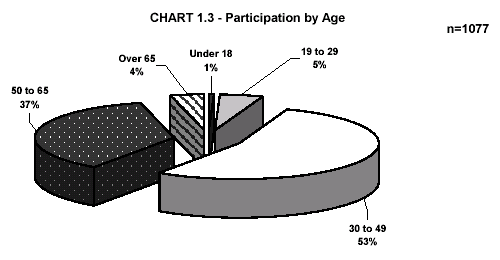
More females than males responded to the issue poll (63% versus 37%). We can only speculate about the reason. The e-consultation process will benefit from hearing the voices of women because we know that the number of female CPP(D) beneficiaries has grown rapidly since 1990 and that current issues regarding eligibility to CPP(D) benefits affect women differently than men. For example, women are more likely to be affected by cyclical and fluctuating illnesses that make it difficult to sustain employment and maintain basic life activities. Some studies have shown that women are twice as likely to develop multiple sclerosis (MS) as men, much more likely to develop chronic fatigue syndrome (CFS), and 10 to 20 times more likely to be affected by fibromyalgia.6 As well, women are more likely than men to have interrupted their participation in the labour market and to have engaged in part-time work. All these factors have an impact on women’s eligibility for CPP(D) benefits (e.g., to be eligible, a person must demonstrate that their disability is “severe and prolonged” and that he or she has contributed to CPP during four of the last six years prior to applying for benefits). Women’s interrupted pattern of employment also influence the amount of CPP(D) benefits they receive because the benefit rate is established, in part, on their total contribution to CPP.7
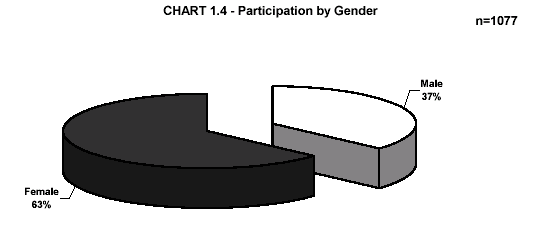
The chart below shows the household income of issue poll respondents. The fact that 42% of respondents indicated that their household income is less than $40,000 is reasonable given that the majority of respondents identified themselves as persons with disabilities and research has clearly established that persons with disabilities tend to have a lower income than the average Canadian.8
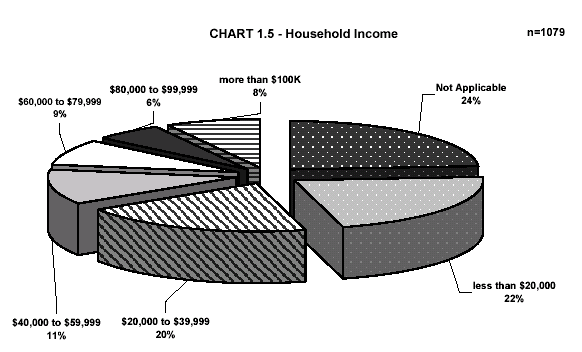
Because we wanted to integrate the e-consultation fully into the more traditional work of our committee, we simultaneously continued with our regular Subcommittee’s hearings as the e-consultation proceeded. We began our study of CPP(D) with meetings to hear witnesses and we continued bringing those with particular views or expertise to our meetings. From February to May 2003, we were fortunate to have the opportunity to hear a full cross-section of views. Our witnesses were: policy experts, national advocacy groups of persons with disabilities, non-government organizations that deal with a particular disability, representatives from government departments, members of the panels that review CPP(D) decisions, the Office of Commissioner of Review Tribunals, polling organizations, medical researchers and practitioners, the Canadian Medical Association, rehabilitation specialists, some provincial representatives, and the insurance industry.
This wide range of witnesses allowed us to test the preliminary results that we were receiving from our e-consultation against their views. They also provided us with a depth of information that allowed us to put the results of our e-consultation into perspective.
In our final meeting on CPP(D), we brought our two “worlds” together — our traditional work and our online consultation. We invited several of the participants from our e-consultation to join us at a regular Subcommittee meeting to discuss the possible recommendations that we could include in this report.
The broad range of Canadians who responded to our e-consultation — all types of life experiences, age, gender, occupations and geographical location — clearly indicates that this process reached a good cross-section of individuals and advocacy groups with an interest in the CPP(D) program. Those who sent us their stories or submitted solutions to the Subcommittee confirmed that we had gained access to a wealth of first-hand knowledge about what was important, what worked well, and where improvements could be made. A very important lesson for all of us was that when people are asked their views, they will respond in a thoughtful, constructive, and open way. Despite the ‘decline of deference’ and the perceived irrelevancy that envelops many parliamentary institutions, Canadians, when they believe that they will be listened to and that their views may make a difference, take up the challenge. And this they told us directly.
The majority of respondents indicated that they enjoyed participating in the issue poll (79% either agreed or strongly agreed); 74% did not think the issue poll was too long; 88% thought the information was easy to understand; and 92% either agreed or strongly agreed that based on this experience, they would participate in an issue poll again.
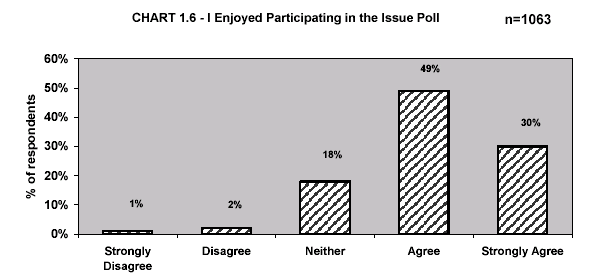
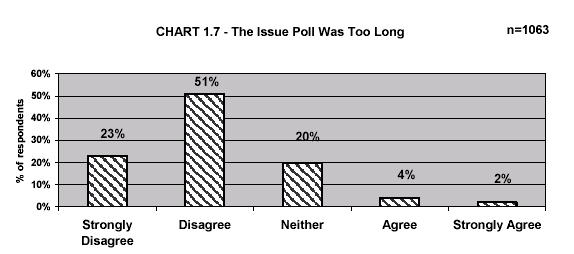
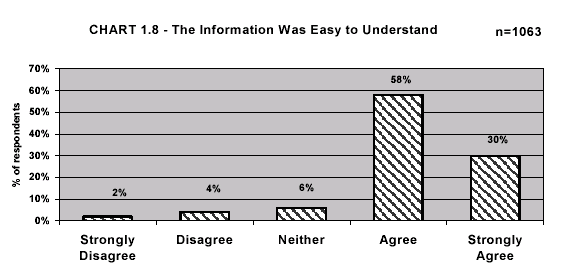
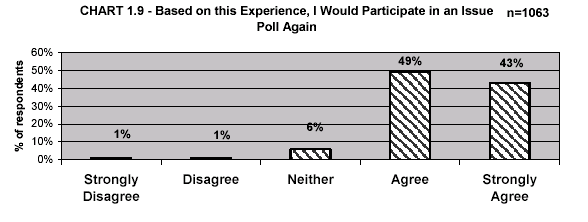
We realize, as should all those who look at these results, that it is important not to confuse the issue poll with a scientific survey. Rather, its purpose was to provide the Subcommittee with a sense of what direction it should take on major issues and challenges facing the CPP(D) program. It also provided participants with some insight into a host of challenges and tradeoffs with potential solutions or action. We feel that we were given access to Canadians’ views in an unprecedented and open manner.
By combining the knowledge that we gained from those who joined us online with the insights provided by those who came to our meetings as witnesses, we believe that we have set out on a course that Parliament, and its committees, could usefully follow.
People also showed us that Parliament can serve as an important information resource. For the e-consultation period (December 2002 through March 2003) the site statistics9 show that users were visiting the Subcommittee’s Web site much more often than they had in the prior months — the Web site received 188,276 page requests. Compared to the same four-month period from the previous year when our Web site had a more traditional format, and only received 1,875 page requests, it represents an astonishing increase in Web site traffic. During the four months from December 2002 through March 2003, 41% of the page requests were generated by interest in policy papers and background documents prepared by the Parliamentary Research Branch.
The e-consultation on the future of the Canada Pension Plan Disability program allowed Canadians a degree of access to parliamentarians that is unprecedented. The Subcommittee strongly believes that online consultations represent the next step in the path towards greater participation by citizens in Canada’s democracy.
Recommendation 1.1
Given the success of the pilot project on e-consultation in complementing its regular committee study of the Canada Pension Plan Disability and providing Canadians with information as well as involving them, the Committee recommends that:
| a. | Each committee of the House of Commons consider putting in place an information-based Web site. Such a site could include common elements (e.g. information about how Parliament works, how committees operate and how to contact the committee) as well as information specifically related to an individual committee’s mandate, activities and background information related to its specific studies. |
| b. | The House of Commons and Library of Parliament be given appropriate additional resources to put in place information-based committee Web sites with the capacity to facilitate e-consultations. |
| c. | The House of Commons and the Library of Parliament should put in place an overall framework or suggested course of action to guide any future e-consultations. |
| d. | Where circumstances warrant, other committees of Parliament consider including e-consultations with Canadians as one of the options in carrying out a study. |
| 1 | Standing Committee on Human Resources Development and the Status of Persons with Disabilities, A Common Vision: Interim Report, Ottawa, 2001, p. 19. |
| 2 | The term respondents will be used in this report to refer to individuals who responded to the issue poll. |
| 3 | A small number of respondents did not identify themselves with any of the categories offered in the issue poll. All these categories are not mutually exclusive however. A respondent could identify with more than one category of identification. (This explains why the total in Chart 1.1 exceeds the total number of respondents.) |
| 4 | Newfoundland (10 respondents), Prince Edward Island (8), Nova Scotia (57) and New Brunswick (41) for a total of 116. |
| 5 | Kevin Kerr, Statistical Overview of the Canada Pension Plan Disability program, Prepared for the Subcommittee on the Status of Persons with Disabilities, Ottawa, 2002, http://www.parl.gc.ca/disability/issues/statistical_2_e.asp. |
| 6 | At this point in time, there are very few scientific studies reporting on so-called “invisible illnesses” such as CFS and fibromyalgia. Nonetheless, several studies have helped to establish the demographics of those affected by these illnesses and tend to show that females are more likely to be affected then men. For example, a U.S. study conducted by the Centers for Disease Control and Prevention from 1989 to 1993 identified a population of CFS patients that were 85% female, with an average age at onset of 30 years. For more information on this particular study, see http://www.cdc.gov/ncidod/diseases/cfs/demographics.htm. |
| 7 | For more information on the adverse impact of
CPP(D)’s current definitions of work and disability on women with
disabilities, see Tanis Doe and Sally Kimpson, Enabling Income:
CPP Disability Benefits and Women with Disabilities, Status of
Women Canada, October 1999, available online at http://www.swc-cfc.gc.ca/pubs/0662279247/199910_0662279247_e.html. |
| 8 | As a point of reference, data compiled by Statistics Canada show that the average total annual income for all family types was $52770in 1998. The total annual income rose to $55292 in 2000 and would likely be higher than this amount today. Source: Income Statistics Division, Statistics Canada. |
| 9 | Site statistics provided by the House of Commons, Information Services. |